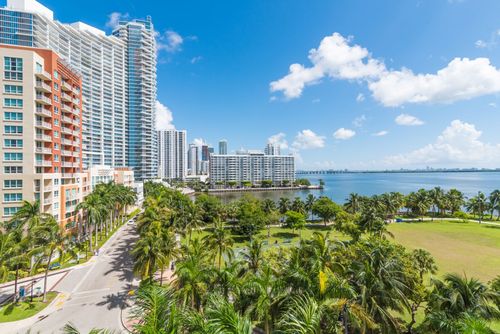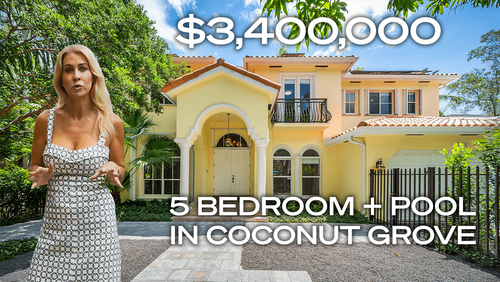If you're looking for a new home in Miami or South Florida, whether to buy or rent, you've probably heard about two of Miami's most iconic neighborhoods -- Coconut Grove and Coral Gables. While these are two highly desirable neighborhoods, and they share some similarities, they each have their distinct flavor.
For starters, Coconut Grove is a waterfront neighborhood in the City of Miami, set on Biscayne Bay, while Coral Gables is an altogether separate municipality, with its own government. Read our Miami Neighborhood Comparison to get a better idea of how these two areas compare so you can know which neighborhood is best for you!
Miami Neighborhood Comparisons - Coconut Grove Coral Gables
This article was first published September 13, 2021. It was last updated August 13, 2022
Lifestyle: Coconut Grove, Miami vs Coral Gables

Coconut Grove Marina - Photo courtesy of CoconutGrove.com
Miami's Coconut Grove is a historical neighborhood, established in 1825, and enjoys a rich history and distinct Caribbean flavor on the shore of Biscayne Bay. Located just south of Miami's key financial district, Brickell, living here means living very close to everything the city of Miami has to offer, but also "away from it all."
A favorite among artists and nature lovers, with a bohemian style, Coconut Grove is also a haven for sailors, boating and those who love coastal living. In fact, the Grove is known for its many marinas and sailing clubs, including the Coconut Grove Sailing Club, Dinner Key Marina, the Coral Reef Yacht Club, and the Biscayne Bay Yacht Club.
Its streets are shaded by lush, green canopies provided by majestic banyans, grand poincianas, and other tropical trees. There's even a population of exotic bird species in the area, including wild peacocks that roam the streets freely, and colonies of parrots escaped from the pet trade who have set up housekeeping in the canopy.

Coral Gables residential community
Coral Gables, known as the “City Beautiful,” is also a city with a rich history, and was the third municipality to be incorporated in Miami-Dade County, after Miami and Miami Beach. Initially, it was a community of single-family homes. While Coral Gables began as an upper-middle-class enclave of sprawling homesites housing the faculty at the University of Miami, it has grown into a diverse city with an artsy, elegant lifestyle. It also has some beautiful residential waterfront neighborhoods to the south of Coconut Grove along Biscayne Bay, dotted with a marina here and there.
The area has retained its Mediterranean architectural charm, and there are now a variety of housing and lifestyle options to choose from. Known for its lively cultural and academic scene, Coral Gables has long been a haven for intellectuals and those who love to live close to Downtown Miami and Brickell but be surrounded by residential tranquility, golf courses and historic gardens.
Business: Coconut Grove vs Coral Gables

Arquitectonica offices. Photo courtesy of Arquitectonica
Coconut Grove is primarily a residential neighborhood, but has a healthy commercial district marked by hotels, small private businesses, and professional service providers, as well as an assortment of retail shops and boutiques, and a delightful variety of restaurants. Most of all of the shops, offices, sidewalk cafes and luxury high rises run along or are centered around Bayshore Drive and the newly renovated CocoWalk. Many people work at home in Coconut Grove, and the area is home to several creative firms, including large media production businesses and recording studios.
The Grove is also home to internationally acclaimed architecture firms, including Arquitectonica, Reveulta Architecture, Strang Design (Max Strang), and Beame Architectural Partnership, as well as several of Miami's top real estate development companies, including Terra Group, Alta Developers, and Swerdlow Group.

Miracle Mile. Photo courtesy of Miami and Beaches
The city of Coral Gables, in addition to its residential areas, also has an impressive downtown with over 100 multinational corporations operating branches or headquarter offices in the area. Today, there are a wide array of businesses in Coral Gables, including hospitals, cosmetic medical facilities and other health care providers, retail shops and luxury brands, and professional service providers such as attorneys, accountants, designers, and real estate agents. The heart of Coral Gables is Miracle Mile, which is lined with shops, cafes, boutique hotels, and restaurants.
Miami Walkability and Transportation: Coconut Grove vs Coral Gables

Biking through Coconut Grove and Coral Gables. Photo courtesy of Bike Walk Coral Gables
Both neighborhoods are winners in this category and are part of why both neighborhoods are so popular. Coconut Grove has always been one of Miami's most walkable neighborhoods even when Miami was largely known as a “car culture city.” Many also bike their way around the area or ride the free Coconut Grove Trolley.
You can get to and from Coconut Grove using the Metrorail and free Metromover. There are also buses serving the Coconut Grove area that connect to other points in Miami, and there's a low-cost Coconut Grove Airport Shuttle to Miami Airport. Coconut Grove also offers several new parking garages, which help keeps the streets pedestrian friendly.

Free Trolley system in Coral Gables. Photo courtesy of Miami and Beaches
The Gables, being a bit more residential in nature, is less accessible by public transportation, although it is served by the free Coral Gables Trolley and the Metrorail, as well as buses that connect to other parts of Miami. It's a little further from Downtown Miami and other popular areas like South Beach (about a 20-30 minute drive).
But living in Coral Gables provides lots of opportunities to get around on foot or on your bicycle, as many commercial retail centers, restaurants, and other businesses are within walking distance of many of the city's newer housing developments. And walking or cycling the residential streets here are really quite beautiful.
Parks and Greenspace: Coconut Grove, Miami vs Coral Gables
Fortunately, both Coconut Grove and Coral Gables offer residents a plentitude of parks, historic gardens, and green space. In this case, Coconut Grove may have a slight edge because of its waterfront location and its many parks. The Grove also appeals to those who like a wilder, tropical feel, whereas Coral Gables has more curated spaces, a historic golf course and historic public pool.

Vizacaya Museum in Coconut Grove
Coconut Grove's lush tropical feel with stately trees everywhere makes living here relaxing, and contributes to all the great open spaces. Two favorites are the waterfront Kennedy Park and Peacock Park, where you can enjoy sports on land and sea, whether you like volleyball or softball or prefer fishing, sailing, kayaking, paddle boarding, snorkeling or diving.
There are also leash-free areas and dog parks for your furry friends. At the Barnacle Historic State Park, nature meets history by the sea. The Kampong National Tropical Botanical Garden, the former estate of botanist David Fairchild, is also a treasured part of Coconut Grove, with many active members. And finally, having the historic Vizcaya Museum and Gardens in your backyard is quite a bonus. The gardens here are truly gorgeous, highlighting the historic home's early European influence.

Coral Castle Museum in Coral Gables. Photo courtesy of Miami and Beaches
Coral Gables also has its share of notable locales and historic sites, replete with plenty of great shade trees and tropical fauna, as well as lots of interesting opportunities to enjoy outdoor adventures. Some notable favorites include the mysterious outdoor Coral Castle Museum and the historic Mediterranean-grotto-style Venetian Pool, built in 1932 and is one of the city's oldest and dearest architectural highlights.
The Gables also includes neighborhoods on Biscayne Bay, and two of Miami's most treasured parks call Coral Gables home. Matheson Hammock Park is a sprawling waterfront nature reserve area from which you can launch your watercraft while also enjoying hiking, biking, and on-land activities, while Fairchild Tropical Botanical Garden is another massive park in southern Coral Gables that is an absolute treat.
The city also has several small parks where you can catch a breeze and stretch out in the open air, such as Ingraham Park, Merrie Christmas Park, and Jaycee Park, and recently acquired five new parks, adding to the many diverse and delightfully shady parks in Coral Gables. Finally, the Biltmore Hotel and Golf Course are favorites for those who love to golf.
Arts and Culture: Coconut Grove, Miami vs Coral Gables

Both of these neighborhoods have a lot of history to them, and have some of the earliest structures in South Florida, including Miami's oldest house. They are both rich in culture and the arts, too. Coconut Grove is home to the first hotel in South Florida, the Peacock Inn. And Coconut Grove's Coconut Grove Arts Festival is also the longest running art fair in the United States.
Miami's Coconut Grove also hosts several neighborhood art fairs and cultural festivals, including the Caribbean-flavored King Mango Strut and Goombay Festival, as well as The Great Taste of the Grove Food & Wine Festival. The Grove is home to several art galleries and artists' studios, as well as the historic Coconut Grove Playhouse, currrently under renovation, and now owned by Miami-Dade County.

The Gables is also known for its world-class theater and arts scene. The iconic Actors' Playhouse at Miracle Theatre presents contemporary theater for audiences of all ages. The GableStage, located inside the beautiful Biltmore Hotel and founded in 1979, produces everything from Broadway and off-Broadway hits to Shakespeare, as well as contemporary new work.
Film lovers can enjoy indie, foreign, and documentary films at the Gables Cinema, one of Miami's most important art-house cinemas. For lovers of outdoor festivals, the yearly Carnival on the Mile brings jazz, funk, Latin, and Caribbean music to outdoor stages on Miracle Mile. And the University of Miami's Lowe Art Museum, as well as the university's music and theater departments, also present excellent exhibitions and performances.
Eating and Shopping: Coconut Grove, Miami vs Coral Gables

Coconut Grove is smaller than Coral Gables and can sometimes be a touristy neighborhood, but it has lots of great shopping and dining options, all set on quaint streets, including CocoWalk, a partially open-air commercial center with food and drink options, boutiques, and a multiplex movie theater. Beyond CocoWalk, the city is known for its laid-back casual eateries, sports bars, and outdoor sidewalk cafés.
You can enjoy the entire range of food choices in the Grove, from vegan to steak and seafood, street food, and food from all over the world. Fine dining options include Lulu, Sapore Di Mare, Farinelli 1937, and the Bellini at Mr. C Hotel by Cipriani. Also try Peruvian fusion cuisine at Jaguar Ceviche Spoon Bar, or traditional Indian food at Bombay Darbar. Enjoy classic Spanish seafood at La Gamba, authentic French cuisine at Le Bouchon Du Grove, and the perfect artisan pizza at Harry's Pizzeria.

Merrick Park in Coral Gables. Photo courtesy of The Shops at Merrick Park
Coral Gables is known for its array of exclusive shopping venues, such as the Village of Merrick Park, the Shops at Merrick Park, and Miracle Mile, where you can find exclusive treasures ranging from designer furniture to fine jewelry. Dining options in the Gables are outstanding, with one of Miami's most eclectic range of eateries. Enjoy Mediterranean food at beloved locations as Caffe Abracci, Graziano's, Tur Kitchen, and Luca Osteria. Or try Threefold Cafe, the only Australian restaurant in town. Talavera Cocina Mexicana has been delighting locals and visitors for years, and Caja Caliente serves exciting Cuban fusion spiced with culinary surprises.
Schools: Coconut Grove, Miami vs Coral Gables

Ransom Everglades in Coconut Grove
Coconut Grove is home to some of Miami's most highly-ranked private and public schools, including the famed Ransom Everglades School and Carrollton School of the Sacred Heart, with their elegant and spacious campuses and elite private education. Other private schools in the area include Saint Hugh, Saint Stephen's Episcopal Day School, Coconut Grove Montessori, the Vanguard School, and LaSalle High School. Public schools that serve the area include Coconut Grove Elementary, Frances S. Tucker Elementary, and George W. Carver Elementary and Middle Schools.

Private schools in Coral Gables include Gulliver Academy and Gulliver Preparatory Schools, Riviera Day School and Riviera Preparatory School, Saint Philip's Episcopal School, Saint Theresa Catholic School, and Saint Thomas Episcopal Parish School. Public schools include Coral Gables Preparatory Academy, Coral Gables High School, and Ponce de Leon Middle School. Charter schools include Somerset Academy and Coral Gables Preparatory Academy.
Architecture and Housing Options: Coconut Grove, Miami vs Coral Gables

The Fairchild in Coconut Grove
Coconut Grove is an architectural blend of old and new, with a wide range of housing options, including new luxury high rise condo developments, older boutique condos, mid-century and Caribbean-style bungalows, as well as opulent waterfront mansions, with the occasional historic building thrown in. And being that it is small, many of these options will have ample green space and/or a park nearby.

Padua Condo Deering Bay in Coral Gables
Coral Gables is by a much more single-family city, and is characterized by Old Spanish and Mediterranean architecture that the city tries to maintain with design guidelines. Here you'll find elegant mansions and estates, manicured single-family homes, townhouses, and the occasional mid-rise condo tower and some newer condo developments sprouting up and offering different types of residential units from townhouses to penthouses.
Cost of Living: Coconut Grove, Miami vs Coral Gables
Of the two areas, Coconut Grove is slightly more expensive, drawing higher-profile investors to higher-priced properties, including many new luxury condo buildings. Average residential listings in Coconut Grover currently range around $1,278,068, or about $569 per square foot, while higher-priced condo listings can run as high as $20,000,000 or $1,987 per square foot (at the time of this posting).
By contrast, the current average listing price for condos in Coral Gables is around $538,586, or $364 per square foot, with a high listing price of $8,995,000, or $1,052 per square foot.
Because Coconut Grove's geography is more surrounded by water, you can expect to pay a slight premium for this. Still, the Grove and the Gables are typically better priced on a per square foot basis than other popular neighborhoods, like South Beach or Downtown Miami.
Should I Move to Coconut Grove or Coral Gables?
Coconut Grove and Coral Gables are close neighbors that share many similarities but somehow retain two distinct flavors. Coconut Grove, with its Caribbean village flavor, attracts more quirky bohemian types and self-made entrepreneurs, as well as many families who seek a relaxed, tropical lifestyle. Coral Gables, known for its understated elegance, also appeals to families and to those who value local arts and culture, but with a more curated community feel. Although both locations provide access to the outdoors, Coconut Grove is more woodsy, while Coral Gables feels more manicured.
The Best Miami Neighborhoods to Live in: Neighborhood Comparisons
If you’d like to learn more about Miami’s most popular neighborhoods and want to see some of our other Miami neighborhood comparisons check out these links:
- Edgewater vs South Beach
- South Beach vs Miami Beach
- Edgewater vs Downtown Miami
- The Miami Beaches: South vs Mid-Beach vs North Beach
- Brickell vs South Beach
- Brickell vs Brickell Key
As you get to know Miami, you'll get to know the subtle personality of each neighborhood. As locals who know the area, we’re happy to help you learn about Miami's diverse neighborhoods and help you determine which neighborhood would be most ideal for you. Just reach out anytime via text, chat, email, or our favorite, give us a call!





